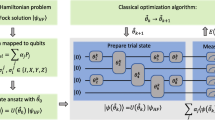Abstract
The electronic Schrödinger equation plays a fundamental role in molcular physics. It describes the stationary nonrelativistic behaviour of an quantum mechanical N electron system in the electric field generated by the nuclei. The (Projected) Coupled Cluster Method has been developed for the numerical computation of the ground state energy and wave function. It provides a powerful tool for high accuracy electronic structure calculations. The present paper aims to provide a rigorous analytical treatment and convergence analysis of this method. If the discrete Hartree Fock solution is sufficiently good, the quasi-optimal convergence of the projected coupled cluster solution to the full CI solution is shown. Under reasonable assumptions also the convergence to the exact wave function can be shown in the Sobolev H 1-norm. The error of the ground state energy computation is estimated by an Aubin Nitsche type approach. Although the Projected Coupled Cluster method is nonvariational it shares advantages with the Galerkin or CI method. In addition it provides size consistency, which is considered as a fundamental property in many particle quantum mechanics.
Similar content being viewed by others
References
Bach V., Lieb E.H., Loss M., Solovej J.P.: There are no unfilled shells in unrestricted Hartree–Fock theory. Phys. Rev. Lett. 72, 2981–2983 (1994)
Bangert, W., Rannacher, R.: Adaptive Finite Element Methods for Differential Equations. Lectures in Mathematics ETH Zürich. Birkhäuser Verlag Basel (2003)
Bartlett R.J., Musial M.: Coupled-cluster theory in quantum chemistry. Rev. Modern Phys. 79(1), 291–352 (2007)
Cancès, E., Defranceschi, M., Kutzelnigg, W., Le Bris, C., Maday, Y.: Computational chemistry: a primer. In: Handbook of Numerical Analysis, vol. X. North-Holland, Amsterdam (2003)
Ciarlet G.P.: The finite element method for elliptic problems. Studies in Mathematics and its Application. North Holland, Amsterdam (1978)
Ciarlet G.P.: Handbook of numerical analysis. Computational Chemistry, vol. X. North-Holland, Amsterdam (2003)
Crawford T.D., Schaefer H.F. III: An introduction to coupled cluster theory for computational chemists. Rev. Comput. Chem. 14, 33–136 (2000)
Flad, H.-J., Hackbusch, W., Schneider, R.: Best N term approximation for electronic wavefunctions I One electron reduced density matrix. M2AN Math. Model. Numer. Anal. 40 (2006)
Flad, H.-J., Hackbusch, W., Schneider, R.: Best N term approximation for electronic wavefunctions II, Jastrow factors, MIS, Leipzig Preprint 80/2005 to appear M2AN Math. Model. Numer. Anal.
Fournais S., Thomas-Ostenhof M., Thomas-Ostenhof T., Ostergaaard Sorensen T.: Sharp regularity results for Coulombic many-electron wave functions. Comm. Math. Phys. 255, 183–227 (2005)
Friesecke G.: The multiconfiguration equations for atoms and molecules: charge quantization and existence of solutions. Arch. Rat. Mech. Anal. 169, 35–71 (2003)
Helgaker T., Jørgensen P., Olsen J.: Molecular Electronic-Structure Theory. Wiley, New York (2002)
Hampel C., Peterson K., Werner H.-J.: A comparison of efficiency and accuracy of the quadratic configuration interaction (QCISD), coupled cluster (CCSD) and Brückner coupled cluster (BCCD) methods. Chem. Phys. Lett. 190, 1–12 (1992)
Kato T.: On the eigenfunctions of many-particle systems in quantum mechanics. Comm. Pure Appl. Math. 10, 151–177 (1957)
W. Klopper R12 methods, Gaussian gemninals. In: Modern Methods and Algorithms of Quantum Chemistry. Ed. Grothendorst. Proceedings Winterschool, NIC Series, vol. 3. Jülich (2000)
Kümmel H., Lührmann K.-H., Zaboglitzky J.G.: Many fermion theory in exps (or coupled cluster) form. Phys. Rep. 36(1), 1–63 (1978)
Kutzelnigg W.: Theory of the expansion of wave functions in a Gaussian basis. Int. J. Quant. Chem. 51, 447–463 (1994)
Kutzelnigg W.: Eror analyis and improvement of coupled cluster theory. Theor. Chimica Acta 80, 349–386 (1991)
Kutzelnigg W., Morgan J.D. III: Rates of convergence of the partial wave expansions for atomic correlation energies. J. Chem. Phys. Letter 195, 77 (1992)
Le Bris C., Lions P.-L.: From atoms to crystals: a mathematical journey. Bull. AMS 42, 291–363 (2005)
Levin M.: Solutions of the Multiconfiuration equations in qunatum chemistry. Arch. Rational Mech. Anal. 171, 83–114 (2004)
Lieb E.H., Simon B.: The Hartree–Fock theory for Coulomb systems. Comm. Math. Phys. 53, 185–194 (1977)
Lions P.-L.: Solutions of Hartree–Fock equations for Coulomb systems. Comm. Math. Phys. 109, 33–97 (1987)
Schütz M., Werner H.-J.: Linear scaling local CCSD. J. Chem. Phys. 114, 661–681 (2001)
Reed M., Simon B.: Methods of Modern Mathematical Physics IV: Analysis of Operators. Academic Press, San Diego (1978)
Simon B.: Schrödinger operators in the 20th century. J. Math. Phys. 41, 3523–3555 (2000)
Szabo A., Ostlund N.S.: Modern Quantum Chemistry. Dover Publications, New York (1996)
Yserentant H.: On the regularity of the electronic Schrödinger equation in Hilbert spaces of mixed derivatives. Numer. Math. 98, 731–759 (2004)
Yserentant H.: Sparse grid approximation for the numerical solution of the electronic Schrödinger equation. Numer. Math. 105, 381–389 (2005)
Yserentant, H.: On the electronic Schrödinger equation. Lecture Notes, Preprint Universität Tübingen (2003)
Author information
Authors and Affiliations
Corresponding author
Additional information
This research was supported by DFG priority program SSP 1145 Modern and universal first-principles methods for many-electron systems in chemistry and physics.
Rights and permissions
About this article
Cite this article
Schneider, R. Analysis of the projected coupled cluster method in electronic structure calculation. Numer. Math. 113, 433–471 (2009). https://doi.org/10.1007/s00211-009-0237-3
Received:
Revised:
Published:
Issue Date:
DOI: https://doi.org/10.1007/s00211-009-0237-3




